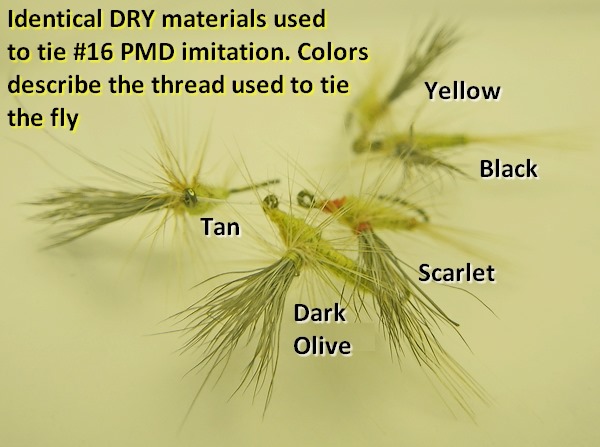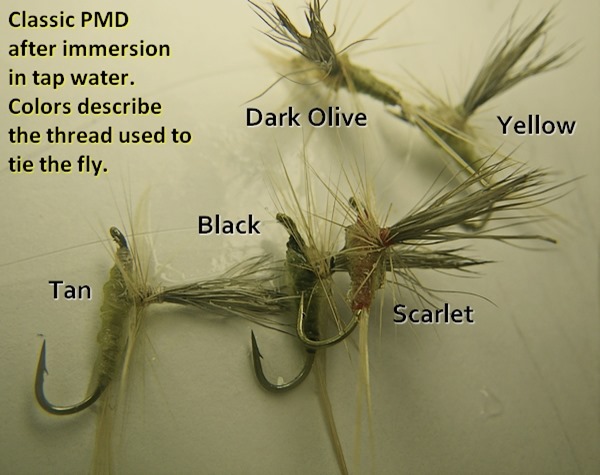Ever watch someone attempt to match a bug in the wild? Minimalism usually overrides complexity as tying while traveling restricts the fly tier to a small subset of the materials than are available at home. Little packets of dubbing compress nicely, and a half dozen necks covers just about everything fished dry.
As your pals cluster over your “canvas” insisting, “ …it was a bit more brown” – and how, “…the ones near me were about a size 12,” invariably the resultant bug when duplicated enough to quench demand, is always dry.
Not the “dry” of dry fly, rather the dry of the desert … bone dry, the opposite of damp.
As the only “fish” able to survive out of water are Snakeheads and our prehistoric ambulatory ancestors, the inconvenient truth is fish live in water and to catch them your fly must get wet. As simplistic as this sounds, this notion eludes most fly fishermen, as attempts at imitation are done using dry materials, under bright lights, rather than wet materials under the dim light of dusk, or under refracted conditions.

The Bad News being that under morning or evening conditions, damp flies change color drastically, and while our painstakingly crafted imitation was anatomically correct and the proper color, its damp, darkened variant may only catch smaller fish forced into the unpopular lies, and the desperate fish that rushed to the bait regardless of its color.
The magic of realistic imitation is a mixture of known and unknown, which makes the topic complex and the outcome so varied. On the one hand, our quarry cannot be queried as to what it just ate, and if it doesn’t, we assume it “smart” – able to count the extra six legs our hackle contained. On the one hand fish are stupid, and any object carried by the current and resembling something living, is eaten without hesitation.
Due to the cost of our tackle and collective ego, fly fishermen insist their quarry is an agile, canny, predator – that can only be seduced by a similarly gifted angler. The reality of “pea-sized” brain and the “instinctive eat” is dismissed as belonging only to drinking buddies or the angler’s offspring.
In actuality, flies are darker when wet than when dry. Fish are likely to eat them, but may not eat them with the gusto reserved for the predominant hatch, and refusals can be more common than a properly colored imitation.
This darkening effect is enhanced by many factors, most important being the underbody and the thread color used to construct the fly. Attempts at exacting imitation of form or color must include an understanding of how thread colors influence the fly when fished.

To illustrate the phenomenon, both of the above pictures were taken of the same flies under marginal light conditions. The “dry” picture flies look reasonably identical other than the bits of thread color showing at whip finish or the post of the parachute wing.
After immersion in tap water, the bugs tied with darker thread reveal their true colors – which no longer resemble the coloration of the original pattern, and in this case, only the yellow and tan versions remain unchanged.
Dry flies are much more vulnerable to the bleeding through of thread colors due to their light coloration and sparse dressing. Fur absorbs water, and most tiers attempt to reduce this absorption by minimizing the amount of fur used in the body.
Nymphs have less exposure to this issue – but are not immune by any measure. Most nymphs tend to tied with darker colors, and thread to match making their color less susceptible to the skew induced with dampness.
Tying flies with neutral colors may not be as fashionable, but they will preserve the intent of the dressing better versus adding unforeseen consequence. For flies dressed in the warm spectrum of yellows through brown, tan thread will neither add color nor darken noticeably, it is the preferred neutral “warm.” For light dun through the olive spectrum, a light gray thread is the preferred “cool” neutral.
Underbodies and the controlled visibility of their thread color is a powerful tool to assist a tier if the effects are planned and understood. Buffering a bright underbody with external fur can yield a “gelatinous” coloration that due to visual effects adds dimension as well as color just like the real bug.
As beginning fly fishermen we are destined for numerous stages to our fishing careers. Choosing to tie flies being one, awareness of our prey and its favorite food groups being a second. Discovery that angling theory is a mix of myth and word of mouth – inevitably leads to entomology and the scientific process … and the desire to imitate versus attract. In our maturation as an angler, it’s inevitable that precise color and exacting imitation will become a dominate chapter, one of many phases we’ll endure in our journey to “Opinionated Old Sumbitch”, the Jedi Master of fly fishing.
